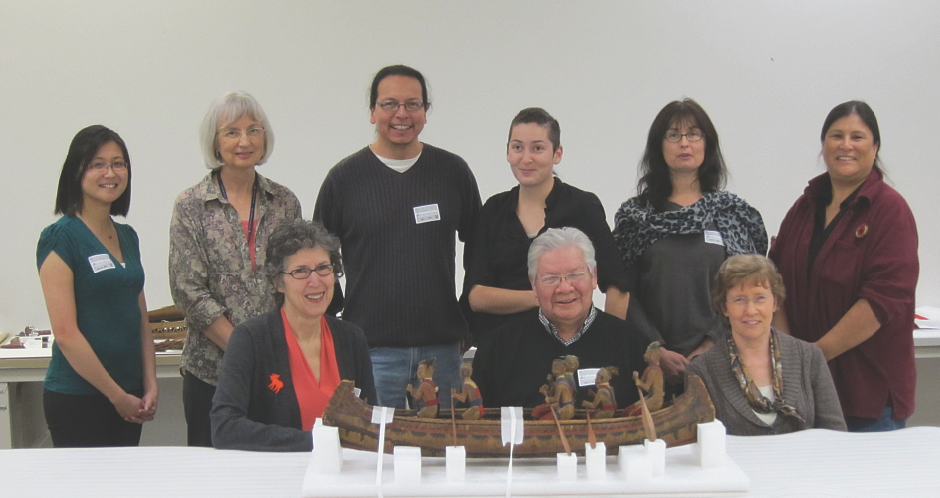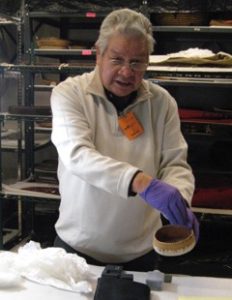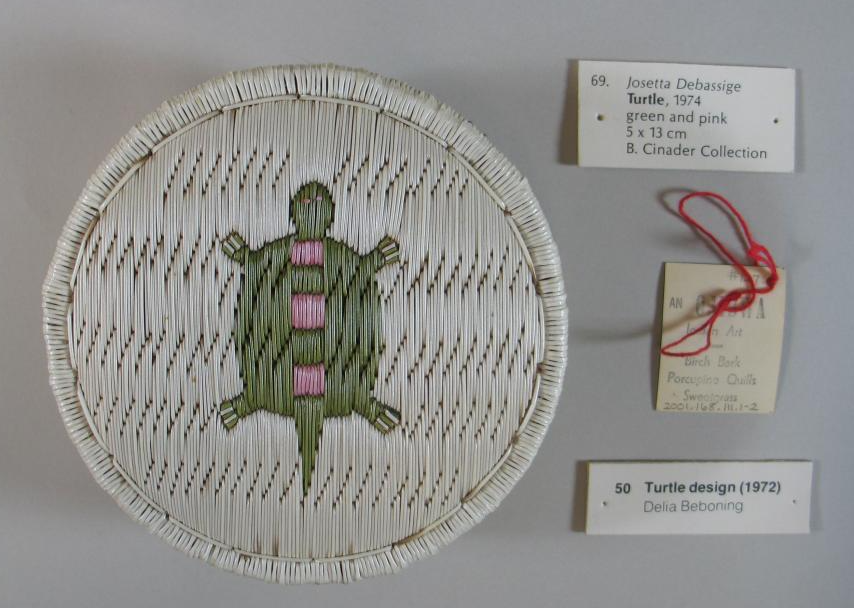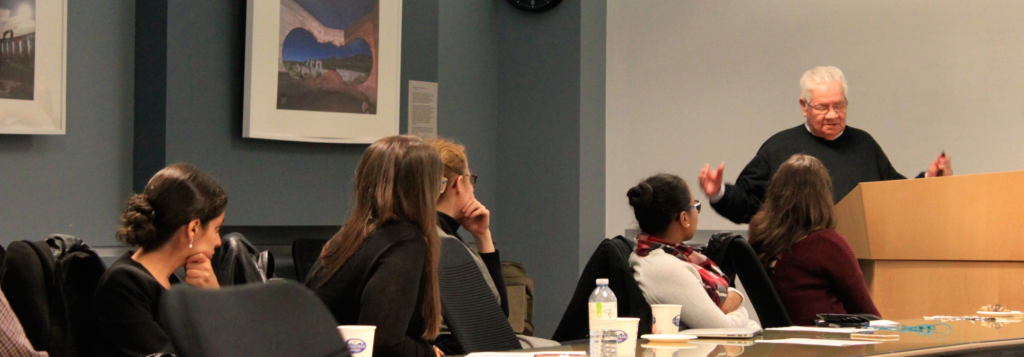A GRASAC Profile Article
Lewis Debassige is a widely respected Anishinaabe Elder from M’Chigeeng First Nation on Manitoulin Island (Mnidoo Mnising). He has been a dedicated member of GRASAC since the organization’s earliest days and has participated in a number of GRASAC-led initiatives to preserve and promote understandings of Great Lakes Indigenous culture, artefacts and history.
Lewis is also a well-known advocate for Indigenous rights and education and has worked on such issues in a number of First Nations communities across Ontario, as well as in regional and national capacities with the Union of Ontario Indians and the National Indian Brotherhood/Assembly of First Nations.
Since Lewis has taught so many of us at GRASAC so much, and always with such grace and humour, it seemed fitting to begin our profile series with him: chi miigwech, Lewis!

“What Does GRASAC Mean to Me?”
Closing Remarks by Lewis Debassige, 2014 GRASAC Research Conference, Woodland Cultural Centre
Transcribed & abridged by Kate Higginson & Julia Gil
“If you want to have an Anishinaabe understanding of this world it has to include science, scholarship and spirit. If you’re reading an artifact, step into the shoes of the person that made it, step into the shoes of the person that owned it and used that artifact, try to connect with that spirit – our ancestors taught us that.
These are not inanimate objects, they have their own energy, they have their own force, they have their own spirit and those things have to be read.
Some of them take on an incorporeal nature and we have to watch out for it. They are ceremonial items. Sometimes we can’t take pictures, we have to do etchings and illustrations on some of these items and that all comes together.

I really enjoyed Amber Sandy’s presentation and her new way of reading these items, because that’s how I think and try to experience these items when I visit them. You are a visitor and like visiting an Elder, or somebody that is just asking for your story, to tell you their stories you must offer tobacco, you should have a smudge if you’re visiting ceremonial items. We did that, Alan and I did that, when we visited the national museum in Gatineau and it helped, it helped me. So then protocol and respect needs to be followed…
So my answer to Crystal’s question, “What does GRASAC mean to me?”
First of all, GRASAC is the meeting of people, the meeting of minds, the meeting of hearts that have the same concern… It’s the meeting, the coming together, doing something to improve the understanding of the past. To encourage young people to visit these heritage items and have conversations with them.
You saw the pipe yesterday with the figure facing the smoker. Same thing with these items: face them, have a conversation with them and they will tell you wonderful stories.
GRASAC: I’ve enjoyed everybody’s company since the beginning, since the first time I’ve met them, so there are very familiar faces and new ones that join as members each time. GRASAC’s growing, there’s a web… That’s how we’re connecting with each other. And it takes time, things do not work out all right all the time but it teaches us how to resolve these things, how to face those difficulties, fighting to be one, and experiencing the Ojibwe culture.
So Crystal, it’s about people, connecting with people, and sharing and enjoying each other’s stories and those items that help trigger other stories from the past, from our ancestors, from those creators or artisans from yore. That’s what GRASAC means to me.
I’ve always enjoyed these GRASAC sessions. I’ve volunteered to say a few words at this session and make these observations. So I thank you again. Chi migwetch. There is one more word: we say maandaag-kwe and maandaag-nini, meaning awesome women and awesome men. So maandaa-nakiim: you are doing awesome work here!


Lewis Debassige & Cathleen Clark talk about GRASAC
December 2016
CC: What do you think are some of GRASAC’s strengths?
LD: Providing an event on site—on a reserve, in a community—that’s a strength. And that has been a priority [for GRASAC] and very well done. The last meeting this fall was at the Woodland Cultural Centre in Brantford. And it needs to continue.
CC: What kind of projects would you like to see GRASAC become involved in?
LD: I would still like to see GRASAC continue to be involved in examining the artefacts around the Great Lakes. With my background, my involvement has always been about education. I found [certain museum] collections very poorly documented.
We need more work in that field because the people that know the traditional way of doing quillwork or moose hair embroidery… they are leaving us. Every year we are losing those people…
I don’t have any background in archeology but I really enjoyed learning about what things mean and how they tell stories. You have to put yourself in the position of the person who made it and try to think of why they made it that way. Whether it was to celebrate an event or something else. Art is so important in the development of Anishinaabe people. Art is a marker of development and that is what GRASAC is dealing with.
CC: Any parting thoughts about the future of GRASAC?
LD: Well, we still have a long way to go. And never enough money. We need the three ‘M’ approach—money, money, money! [laughs] But… it’s not always about money. Sometimes you have that but not the family feeling with the people you are working with.
GRASAC is about people. People coming together because of their common curiosity. And that’s what we are as a group—we have different views, different perspectives. But we come together and talk about it and we have good fun. We enjoy each other’s company and we are becoming a community.

Lewis Debassige Speaks at the University of Toronto (November 2016)
Written by Cathleen Clark
In November 2016, the Centre of Indigenous Studies and the Department of History at the University of Toronto welcomed Lewis to the university’s St. George campus to take part in a series of speaking engagements about his work as an activist in the early 1970s and lifelong engagement with Indigenous education initiatives. Lewis spoke to undergraduate students in a third-year “Indigenous-Newcomer Relations” history course, served as the guest of honour at a special lunchtime Q & A hosted in the Turtle Lounge at the university’s First Nations House, and concluded his talks with a formal lecture delivered to students and faculty at the Department of History. Though each session differed in style and audience, Lewis began each talk by sharing some of his personal background and acknowledging how his family and community history shaped him as a person and set him on his path as an advocate for Indigenous peoples. He credited much of his sense of duty and cause to his close relationship with his grandfather, who served as both his teacher and role model for responsible leadership.
With his characteristic humour and engaging oratory style, Lewis also treated his audiences to an insightful and entertaining account of his first foray into the national political scene. In the summer of 1969 he, along with six other young First Nations men, including the well-known Nihawak (Cree) leader, Harold Cardinal, were called to Ottawa to develop a rebuttal to the federal government’s newly announced “Statement on Indian Policy.” The policy—better known as the infamous 1969 White Paper—proposed to eliminate distinct legal Indian status, gradually dissolve reserves, and assimilate Indigenous peoples into so-called ‘mainstream’ Canadian society. It alarmed and drew criticism from First Nations peoples across Canada for its failure to recognize the unique status of Indigenous peoples and its dismissive treatment of historic treaty agreements. According to Lewis, he and his colleagues that summer knew exactly how important their work was and the enormity of the consequences Indigenous peoples would face should they fail to shut down the government’s proposal.
As such, “The Magnificent Seven” (as Lewis jokingly called them) began to envision a different relationship between Indigenous peoples and the Canadian government—one that recognized and affirmed treaty rights and honoured the special status of Indigenous peoples as citizens with additional inherent rights.
Not long after, based on the ideas from the group’s sessions in Ottawa that summer, Harold Cardinal published the “Citizens Plus” or “Red Paper” manifesto. The Red Paper not only served as a rallying cry against the government’s proposal but also marked the launch of an unprecedented level of Indigenous organizing and activism and became a key contribution to the Canadian Red Power Movement of the 1970s.
With the success of the Red Paper and the government’s withdrawal of the White Paper policy, Lewis went on to work for the Union of Ontario Indians and the newly established National Indian Brotherhood where he is credited as one of the authors of the historic 1972, “Indian Control of Indian Education” policy paper. Later he returned home to M’Chigeeng First Nation and served as an education administrator while continuing his work as a promoter of Indigenous control of Indigenous education. Today he continues to work on various projects promoting Indigenous education and culture and language revitalization initiatives.

While at the University of Toronto, Lewis spoke with considerable pride of his community’s many successful institutions, like the Kenjgewin Teg Educational Institute for postsecondary education and the Ojibwe Cultural Foundation, where he served as one of the first founding directors. Though honest about the historic and ongoing struggles and challenges facing Indigenous peoples, Lewis, armed with magic tricks and optimism, always left his audiences with an encouraging message that promoted positive thinking for the future and a call to action to take part in the change to come.
